Goals vs Objectives: The Simple Breakdown
Everyone on your team should understand the difference between a goal and an objective. I know it sounds simple, but terminology confusion is one of the biggest causes of misalignment in business strategy.

Everyone on your team should understand the difference between a goal and an objective. I know it sounds simple, but terminology confusion is one of the biggest causes of misalignment in business strategy.
Whether you use the OKR model, the KPI framework, the Golden Circle, or another methodology, the difference between goals and objectives must be made abundantly clear. Without this shared knowledge, teams could risk wasting time on irrelevant activities, at best, or working against a common purpose, at worst.
Here, we'll explain the difference between goals and objectives and discuss some of the most effective goal-setting frameworks used by marketing professionals today. You’ll also find measurement tactics to track your progress. By the end of this post, you can wave goodbye to ambiguity when it comes to your long-term and short-term marketing plans.
Goals vs. Objectives
A goal is an achievable outcome that is typically broad and long-term. A company might use goals to inform yearly strategies that each department will execute. An objective, on the other hand, defines the specific, measurable actions each team employee must take to achieve the overall goal. To sum it up, the main difference between a goal and an objective is that goals provide direction whereas objectives measure how you should follow that direction.
Goals are undoubtedly critical to your business's success. Ultimately, your company's goals should align with your vision and mission in order for employees to best guide their own actions and decisions.
For instance, let's say this year your leadership team has outlined three broad goals for your company:
Create a more inclusive workplace culture Grow international brand awareness Increase customer retention by 40%Great…now what?
Here's where objectives come into play — objectives are essentially the measurable actions you can take to achieve your overall goals. Typically, you'd use the S.M.A.R.T. criteria to define and measure specific objectives.
Featured Resource: Free SMART Goal Template
Download this Template for Free
"Create a more inclusive workplace culture" is an admirable and important goal to have, but it's vague and too broad to measure. Does "more inclusive" mean one diversity and inclusion panel discussion, or does it mean a 10% increase in women in leadership positions?
Ultimately, your objectives will help your employees understand exactly what you expect from them.
In another example, let's say you inform your marketing department that your overall goal is to "grow international brand awareness".
Now, when your social media marketing manager is crafting her quarterly video campaign, she'll think to herself — Hmm. How can I increase international brand awareness?
She can cater her objectives to fit company goals, as well as her own personal vision. Perhaps she decides, "To demonstrate my success at increasing international brand awareness, my objectives for my video marketing campaign will be a) 10% of all form submissions come from outside the U.S., and b) an increase in engagement from Spanish-speaking Facebook fans by 5%."
Your social media marketing manager can then use her unique objectives to measure whether or not she's contributing to the larger company goal of increasing international brand awareness.
As you can see, objectives can be uniquely tailored to fit each departments' needs, and allow for a large amount of autonomy. By instilling clear and firm company goals, you can feel confident that your employees are all working in the same direction, but taking largely different steps (e.g. objectives) to end up at the same finish line.
Strategy vs. Objective
An objective is a measurable, specific action an employee or team needs to take to meet the needs of a larger company goal. A strategy, on the other hand, defines how each employee or team will accomplish the objective. A strategy can change throughout the course of a campaign, while an objective should remain the same. For instance, perhaps your objective is to increase website traffic by 10%. A strategy to ensure success could be to focus heavily on SEO efforts, re-design the website, or put more money behind your paid advertising approach.
There's one more term differentiation you need to know — objectives versus strategy.
Referencing our example above, let's say your social media marketing manager decides one of her objectives will be "an increase in engagement from Spanish-speaking Facebook fans by 5%".
This is aligned with your company's goal to increase international brand awareness.
A strategy, then, tells your employee or team how she can accomplish her objectives. For instance, your social media marketing manager might decide to focus her paid efforts on Spanish-speaking countries, using Facebook's location targeting features. Alternatively, maybe she decides to cultivate partnerships with international companies and posts videos in Spanish on Facebook specifically highlighting the work of those international organizations.
Both of these options are examples of strategies.
Her strategy might change over time. She might decide her paid efforts aren't working, and try something else. Ultimately, however, her objective (increase engagement from Spanish-speaking Facebook fans by 5%) should remain the same.
Types of Goals
There isn’t a one-size-fits-all approach to communicating goals. There are many things businesses want to measure, especially from a marketing perspective, so it’s important to have several types of goals to choose from when setting the course for the year ahead.
Time-Based Goals
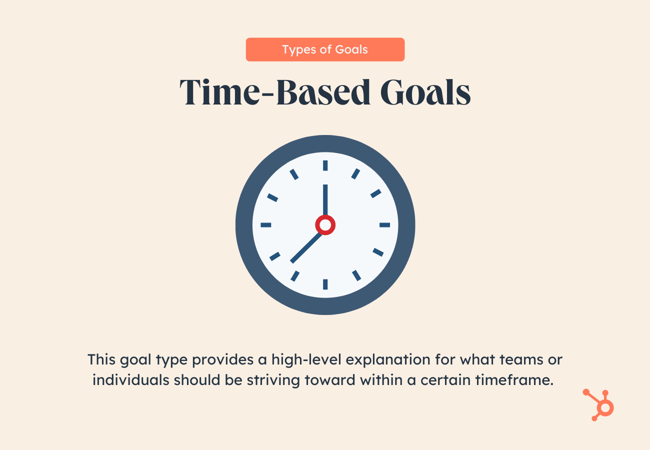
The first type of goal that businesses use to set a strategic direction is the time-based goal. This goal type provides a high-level explanation for what teams or individuals should be striving toward within a certain timeframe. Time-based goals can be short-term or long-term depending on the needs of your organization.
Time-based goals help teams and individuals plan and execute urgent tasks. Some goals are time-sensitive and the primary outcome of achieving these types of goals is that they’re completed on time. Depending on the needs of your organization, you can track these goals in a variety of ways such as note-taking software, and visualize them using timeline maker software.
An example of a time-based goal might be “Increase revenue by 10% to qualify for the best-in-class awards ceremony in August.” Because the award’s ceremony has a fixed date and the action stated in the goal is a requirement of the ceremony, this goal should be time-bound to increase the likelihood of reaching it.
Outcome-Oriented Goals
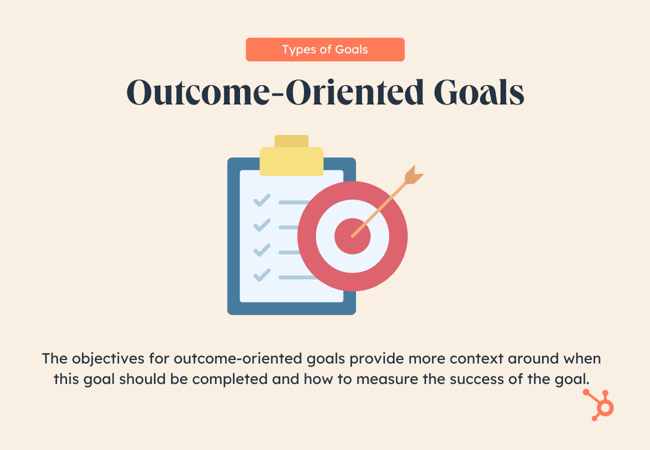
Outcome-oriented goals are independent of a specific timeframe and typically outline what the business is aiming to achieve at some point in the future. The objectives for outcome-oriented goals provide more context around when this goal should be completed and how to measure the success of the goal.
For big picture changes, leadership transitions, and other types of major business milestones, outcome-oriented goals are used to communicate a new vision and era within a company. Objectives for this type of goal communicate actionable changes for employees, and therefore, pair well with process-oriented goals which we talk about next.
Process-Oriented Goals
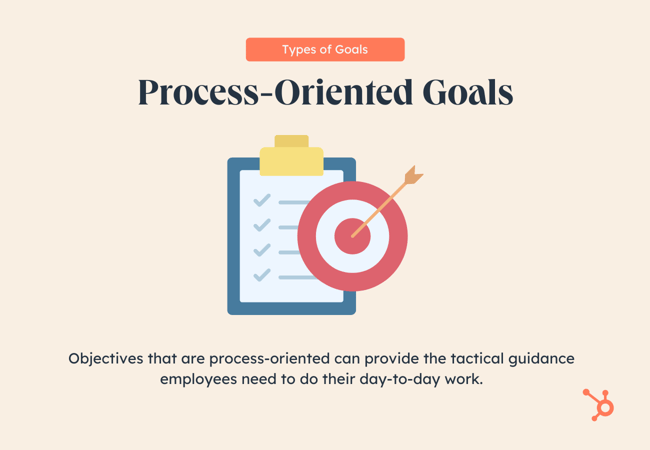
If your business is aiming to set the direction for new workflows and processes, a process-oriented goal is the best choice. A process-oriented goal does not explain what outcome is being achieved. Instead, this goal type is prescriptive and explains what the team is responsible for doing in order to achieve an outcome.
Objectives that are process-oriented can provide the tactical guidance employees need to do their day-to-day work. This goal and objective type works well during transition periods where change management is underway in a company. Process-oriented goals may be short-term or even temporary because once they’ve been achieved, the new and improved processes can be put into action on a regular basis.
How to Measure Goals
Measurement is a key component of any S.M.A.R.T. goal, but how exactly do you measure one? There are a few ways to determine if your actions yielded the desired outcome of your goals. Let’s take a look at them below.
Ask a Closed-Ended Question
First, the simplest way to measure a goal is by asking whether or not you met it. If your goal was written clearly, this should be fairly simple. Process-oriented goals are the easiest to measure in this way because they’re usually yes or no answers.
For example, if your goal is to hold a quarterly alignment meeting between your department and another, you can answer “yes, the two teams had a quarterly alignment meeting” or “no, the quarterly alignment meeting didn’t happen.” For goals that weren’t met, be sure to note the reason why so that you can revisit the goal at your next planning session and determine if it’s worth trying again in the future.
Use a Points System
Multi-faceted goals can be difficult to measure, but if you have a guideline to follow when writing the goal, you can use that same guideline to measure it. For example, if your goal is to launch a new website by quarter three, you can split this goal into two measurable parts: the action and the deadline. If the team launches the website on time, the goal can be measured by awarding it two points — one for the action, and one for completing the action on time. If the website was launched late, the goal can be measured by awarding it only one point for completing the action and none for the deadline.
The points system should be specific to your organization and align with a larger measurement system that is connected to performance or revenue. Don’t forget to communicate the points system before you begin planning goals so that everyone is aware of how the goals will be measured.
Follow a Rubric
Qualitative goals and goals without strict deadlines are difficult to measure because there are fewer numbers involved. In this case, you may find a rubric system useful when measuring these types of goals. With a rubric, you’ll have an opportunity to evaluate the context surrounding the goal and adjust the way it is measured.
For instance, your team was working toward a process-oriented goal that, unfortunately, didn’t make the process easier. Instead, the team has reported longer workflows and more bottlenecks than they had before. In this case, a rubric can help determine what you expected the outcome of this goal to be and document what actually happened in order to report this goal as unsuccessful.
How to Measure Objectives
Because objectives are more specific than goals, they’re more straightforward to measure. To measure objectives, you can use one of the following concepts.
Measure Attainment
Most objectives will feature quantitative data like units, numbers, and figures. This means you can measure the progress you’ve made toward the outcome you expected to achieve.
Let’s say your team wanted to generate 500 leads from a marketing campaign, and they managed to get 475. The attainment of that original 500-lead goal is 95%.
(475/500*100) = 95% Goal Attainment
As with any measurement, your organization can determine what is below average, average, and exceptional attainment which may differ by team or department.
Measure Qualitative Data with Surveys
For objectives that aim to change behavior or are affected by people in another way, quantitative measurements may not tell the full story of whether or not you met your objective. Surveys, focus groups, and other behavior measurements can provide the data you need to measure success.
In HR functions, the team may want to improve employee satisfaction within the sales team. There isn’t a sole quantitative metric that can be used to measure this objective. Surveys like the eNPS can be a great way to measure a shift in culture that leads to changes in the company culture.
Measure Past Performance vs. Current Performance
Can you name a company that doesn’t want to improve its brand awareness? Neither can I. This is one of the most common objectives to measure on marketing teams, but it’s also one of the most difficult to measure. Everyone tracks it differently, so how do you know for sure if you’re measuring it correctly? How do you know if someone is aware of your brand now compared to a month ago without asking every single person in your target audience?
For objectives like this that hold valuable insight, you’ll have to get creative and define your own metrics to measure. In this example about brand awareness, one way to measure it is by comparing how many direct searches or branded search terms you’re receiving now compared to a point in time in the past. Sure, it’s not perfect, but it is constant — that means you’ll have a fixed number to compare against. As long as your stakeholders agree on what metrics and numbers to compare, you’ll find that measuring these types of objectives isn’t so hard after all.
Examples of Goals and Objectives
Scenario 1: A Milestone Goal
Goal: Open a new company HQ in Phoenix, AZ by Q4.
Objective: Obtain all licensing and permit documents by Q2.
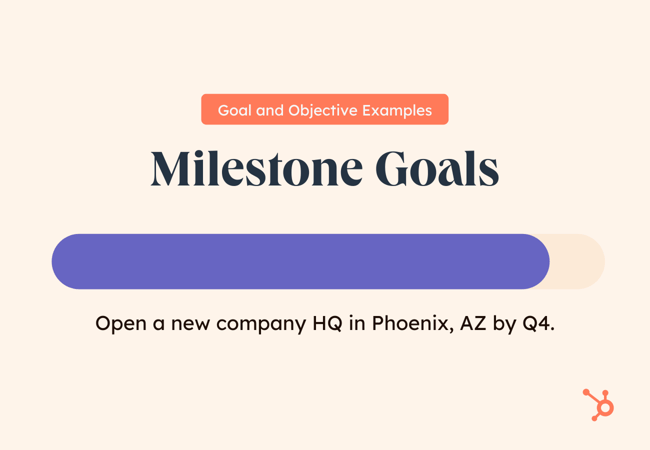
In order to open a new HQ, you’ll need to do a lot of planning before Q4 to achieve the goal. Objectives will help keep you on track so that every step of the way is accounted for.
How to Measure a Milestone Goal
To measure the goal and objective in this example, you can use either the "closed-ended question" framework or the "points" framework. Did you open the new HQ? If so, you’ve met the goal according to the "closed-ended question" measurement. Did you open the new HQ on time? If not, award yourself one point for completing the activity and zero points for completing it late.
By the end of Q4, each objective will have been built upon one another to reach the overall goal of opening the new HQ.
Scenario 2: A Growth Goal
Goal: Increase company market share by 10%.
Objective: Grow customer base by 22% month-over-month for the next 12 months.
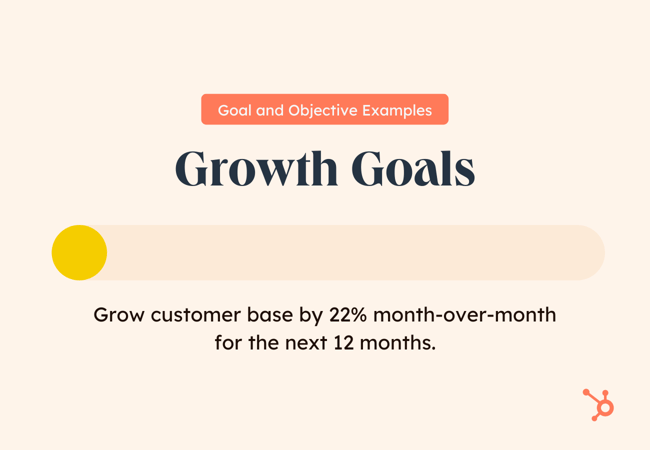
We see that the goal and the objective are dependent on one another, and one way to grow market share is to acquire new customers.
How to Measure a Growth Goal
Because this goal is high-level and slightly vague, you may try to measure it by itself using the "closed-ended question" framework, but I’d suggest you don’t — here’s why. A goal like this can be affected by several other factors that aren’t outlined in your objectives. Those factors may even be outside of your organization’s control.
When Popeye’s launched its chicken sandwich campaign, it didn’t expect to gain market share in the chicken sandwich category so quickly. Due to factors outside of its control, the company met its goal, but that success probably had little to do with the objectives the company originally set to achieve that goal. While it’s not a bad thing that the company achieved its goal, it’s important that your objectives explain why that goal was achieved.
Measuring the objective in this example using the attainment framework will not only give your stakeholders an idea of how closely you met the goal due to activities within your control, it’ll highlight any factors that affected your goal but weren’t included as objectives. This will inform your team on what to include during the next goal-planning session.
Scenario 3: A Quantitative Goal
Goal: Reduce donut cost by 18% in the next five years.
Objective: Switch to a lower-cost sugar provider in the next six months.
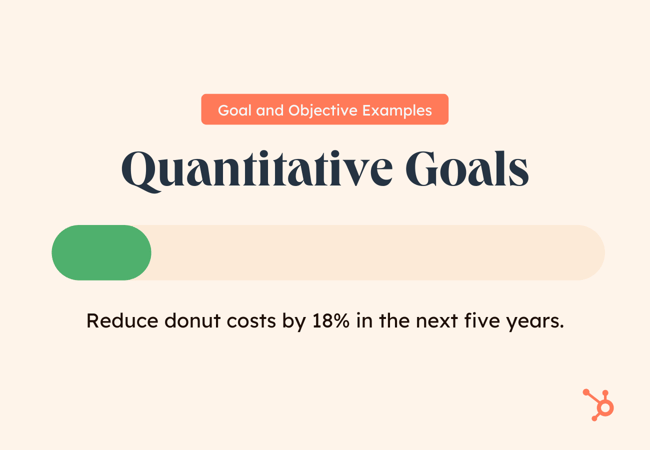
The goal in this example is outcome-based and time-based while the objective is process-oriented. The goal and objective are closely related to one another, but the two will need to be assessed differently in order to measure success.
How to Measure a Quantitative Goal
Use the attainment framework to measure the goal and the past vs. present metric for the objective. As each objective focuses on lowering the cost of the materials that make up the product referenced in the goal, the closer you’ll be to achieving the goal. Therefore, you’ll want to make sure to compare the new vendor’s price of sugar, in this case, to the previous vendor’s price. At the five-year mark, use measure attainment to the goal of 18% to determine if you met or exceeded the goal.
Set Effective Goals and Objectives For Your Team This Quarter
Goals and objectives are often used interchangeably, but they serve different purposes in business. Using the same language to describe the direction and progress within your organization will keep everyone on the same page and working toward the same outcome.
Although these two terms have specific definitions, don’t get too caught up in the semantics — remember the most important part of goal-setting is getting the work done and showing results. If you’re not sure where to start, we’ve got you covered. Download the free marketing goal-setting template below to get your team moving in the right direction.
Editor's note: This post was originally published in April 2019 and has been updated for comprehensiveness.

 Tekef
Tekef 













_1.jpg)
![Why Email Marketing Matters for Monetization with Alex Cattoni [VIDEO]](https://www.digitalmarketer.com/wp-content/uploads/2022/05/EMAL_MARKETING_MONETIZATION-1.png)


















![How To Host Or Migrate A Website In 2025: Factors That May Break Rankings [+ Checklist] via @sejournal, @inmotionhosting](https://www.searchenginejournal.com/wp-content/uploads/2025/05/featured-508.png)